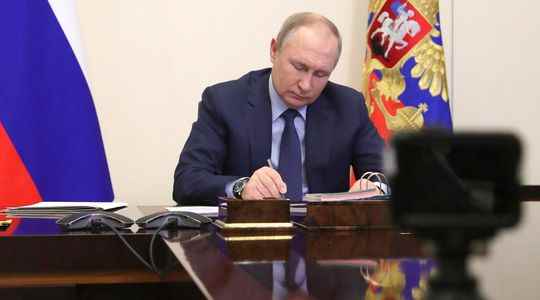Monday, May 9, the Russians will hang on the lips of their despot. In Moscow, this date commemorates the capitulation of Nazi Germany in 1945, the occasion as every year for the head of the Kremlin to address his people during a traditional speech. Context of war obliges, Vladimir Putin will evoke the military invasion in Ukraine, where his troops have been bogged down for more than 70 days. If the intentions of the former KGB agent remain unclear, he has got into the habit of manipulating historical concepts to deny Ukraine’s sovereignty. Among them, that of “New Russia”, which has been used for several weeks as a justification for cutting up the Ukrainian neighbor.
The idea of ”New Russia” aims to cover southern and eastern Ukraine, as well as the Moldavian regions of Transnistria and Gagauzia. “The New Russia project consists of appropriating the entire circumference of the Black Sea. This historical and administrative reference could probably be used as an argument aimed at providing historical validity to the aims of Vladimir Putin”, underlines to L’ Express, Antoine Nivière, professor at the University of Lorraine, specialist in the cultural history of Russia.
The expansionist project was recently outlined by Rustam Minnekayev, deputy commander of the forces of the Central Russian Military District. On April 22, he displayed Moscow’s war aims: “One of the objectives of the Russian army is to establish total control over the Donbass and southern Ukraine”. The general specifies: “The control of the south of Ukraine is also a corridor towards Transnistria, where we also observe cases of oppression of the Russian-speaking population.”
The route planned by New Russia is consistent with the strategic repositioning of Kremlin forces, which were redeployed in eastern and southern Ukraine in early April. “If we look on a map at the part of Ukraine occupied by Russian troops today (early May), it almost corresponds to the territories of Novorossia and it seems to me that this is intended. (… ) They still lack Odessa, which was the capital of “New Russia” at the end of the reign of Catherine II and whose first governor was a Frenchman, the Duke of Richelieu”, explains Antoine Nivière. Nicknamed “the pearl of the Black Sea”, it would constitute a crucial maritime outlet for Russia.
A term from the 18th century
Historically, Novorossia refers to 18th century Russia, the time of the Tsars. In 1774, Russia imposed its power on this region located along the Black Sea, which included the Sea of Azov, and extended to the current border of Moldavia. More specifically, this area corresponded to the current regions of Mykolaiv, Odessa, Kherson and Kirovograd, as well as part of Donetsk Oblast. Under the reign of Catherine II, a colonial policy took hold with the establishment of Slav populations. “This administrative organization disappeared in 1874, we never heard of it again”, comments Antoine Nivière.
“For several years, as part of Putin’s political project which aims to reintegrate all or part of Ukraine into the Russian Federation, this old administrative notion of the Russian Empire has reappeared”, continues Antoine Nivière. In 2014, the expression was unearthed from the past by pro-Russian separatists in Ukraine. Following the non-signing of an association treaty with the European Union, Ukraine is engulfed in a major crisis, caught in a vice between pro-Europeans and pro-Russians.
Novorossia reappears in 2014
In addition to the dismissal of Ukrainian President Viktor Yanukovych, there are demonstrations hostile to the new provisional government in kyiv, pro-European, in the east and south of the country. “Novorossia reappeared in 2014, because there was a need on the part of pro-Russian separatists to find a denomination that could allow them to express their singularity, namely the fact that they had separated from Ukraine and that they wanted a large autonomy, if not independence”, unfolds Pierre Lorrain, historian and specialist in Russia and the post-Soviet world, author of the essay entitled Ukraine, a story between two destinies.
During an interview granted, on April 17, 2014, to the program Direct line with Vladimir Putin, the Russian president drives the point home: “Ukraine is ‘New Russia’, that is to say Kharkov, Lugansk, Donetsk, Kheerson, Nikolaev, Odessa. These regions were not part of the Ukraine at the time of the tsars, they were given to kyiv by the Soviet government in the 1920s. Why did they do it? God only knows.” Implicitly, the head of the Kremlin suggests that these territories must be recovered.
This declaration comes shortly after the oblasts of Donetsk and Luhansk, located in the Donbass region (eastern Ukraine), proclaimed their independence. Pavel Goubarev, self-proclaimed governor of the People’s Republic of Donetsk from March to November 2014, welcomed this outcome, declaring on the microphone of the Russian channel Rossia 24 in May 2014: “This new entity [la République populaire de Donetsk, NDLR] is only a first step towards the great New Russia [Novorossia]”.
New Russia, however, turns out to be more of a “historical name” than a political concept, tempers Pierre Lorrain. Shortly after the annexation of Crimea, the term would have lost its luster: “New Russia is a historical context. It is mainly ultranationalist elements and despisers of Russia in the West who use the word now.”
For the specialist, Novorossia remains generally very little mentioned. The important thing for Russian power is the Donbass, and “this really means something from an economic and industrial point of view, as well as geopolitics.” It should be noted that the Donbass is home to significant reserves of coal and many coal mines. “Vladimir Putin does not speak of Novorossia. The term has not been commonly used for two centuries. Politically, today, it is the concept of Donbass which is used”, concludes Pierre Lorrain.
One thing is certain: the speech on Monday May 9 could mark a new turning point in this conflict.
